Murders in the Rue Morgue, The Old Dark House (1932)
Directed by: James Whale, Robert Florey
Written by: Edgar Allan Poe, J.B. Priestley
Starring: Bela Lugosi, Boris Karloff, Charles Laughton, Leon Ames, Melvyn Douglas, Sidney Fox
In 19th century Paris, Pierre Dupin, a young medical student, his fiancée Camille L’Espanaye, and two friends are visiting carnival sideshows including one by a certain Dr. Mirakle, who is exhibiting Erik. Erik is an intelligent gorilla who Mirakle understands and can hold conversations [I’m not making this up] with. When both man and ape show an interest in Camille, the group leaves. That night Mirakle kidnaps a prostitute but she is unsuitable for his purposes so he kills her, making it obvious that he is responsible for a series of murders of young women in the city. Mirakle wants to mate Erik with a human but none of the candidates have been suitable….until now….

When one thinks of Universal Horror, it’s usually the films featuring Dracula, Frankenstein, the Wolf Man, and the Mummy that come to mind. The studio did make a few films not featuring these classic characters though, which are largely forgotten now but are worth looking at. The first was this sometimes interesting but awkward movie. Now I love these films, but you can’t get away from the fact that, after Dracula and Frankenstein, Murders In The Rue Morgue, based on an Edgar Allan Poe story that has been filmed several times since, it is a considerable disappointment. As we shall see though, this was not entirely the studio’s fault. This was a film I had never seen until last week and watching it is rather a strange experience. It’s sometimes unintentionally funny [something the first two films manage to avoid even when seen these days], is sometimes a bit dull, and makes little sense, but has some striking scenes and is at least great to look at. A classic it certainly isn’t though, and I can understand why it’s not a film that is much talked of or seen nowadays.
After being replaced on Frankenstein by James Whale, director Robert Florey was offered Murders In The Rue Morgue. Similarly, Bela Lugosi, who of course didn’t end up as the Frankenstein Monster, was given to chance to star in what was something of a complimentary package for director and star. The Poe story the film was based on was the first of three stories by the author to feature C.Auguste Lupin, a detective who was something of a precursor to Sherlock Holmes, and in fact this one would make such a great Holmes tale that I’m surprised it hasn’t been adapted into one yet. Florey though ignored much of Poe’s story and only really used the setting, the murderous ape, his master and a hero [though not an actual detective] called Lupin, with the result that the film bears little resemblance to it. The production began in late 1931 and went smoothly but post-production certainly did not. Despite the fact that this was just before the Hays Code came into being [well, it was already around, but only in 1934 did it became ludicrously repressive and very strictly enforced], Murders In The Rue Morgue lost about twenty minutes from the censors [soon afterwards, Freaks would lose even more!]. Now exact details of the cuts seem to be unavailable, but I’ll wager that you originally saw Mirakle kidnap and kill more of his victims, and I would also imagine that his intent to mate Erik with a human woman was more obvious – in the film as it stands, all they mention is ‘mixing blood’. I’m wondering if the film was just considered too long as well, as bits of other scenes seem missing and the movie as a whole is very choppy.
Murders In The Rue Morgue certainly doesn’t begin very promisingly, even with the title sequence that replays Swan Lake again and has the same images behind the words as Frankenstein‘s titles. Lupin and his three companions are going round the carnival sideshows, and soon find Mirakle and Erik. He claims that he and Erik can communicate, and communicate they do, in a hilarious bit where the ape is seen to whisper growls into Mirakle’s eye and he translates what the gorilla is saying in English. Even in 1932, audiences must have fell about laughing. Then Mirakle gives a daft speech, which almost seems directed at the film audience, about how apes and humans are more similar than you may imagine. Things then progress in reasonable fashion until we suddenly cut into a fight between two men over a woman in a beautifully fog shrouded street. I reckon that the first part of this scene was cut, and I believe that it probably explained that the woman was a prostitute and the two men were either clients fighting over her or a client and her pimp. This now very random sequence ends with Lugosi finding the woman, and he really is quite menacing here, since so far you don’t know exactly what he intends to do with her. Then we cut to her tied to a cross and injected with something, and though this scene is obviously very censored, the Sadean imagery here is quite strong.

Sadly after this the film becomes none too interesting for a while. Leon Ames is a very dull male lead, and though he’s not really playing Poe’s detective, he still has a loft where he has lots of beakers and early forensic stuff. There’s quite a bit of comedy, which climaxes in a scene [which is actually from Poe] where several people are trying to get their point across but are all speaking different languages, but much of it seems like padding. As I’ve said before, I would imagine the original cut had far more of Mirakle and his ape. Things eventually build to a climax with the ape turning on Mirakle for no apparent reason and a rather exciting final reel with Erik leaping about the rooftops of Paris carrying Camille. Watching this scene, it becomes apparent that the model of this film was actually the silent The Cabinet Of Dr Caligari, and this extends partially to the sets and the whole look of the film. When the script is often very poor, there is almost always something interesting to look at. The sets are full of beams in the ‘wrong’ places but it’s Karl Freund’s photography that is truly remarkable. He uses things like forced perspective and odd angles to create a feeling of a nightmare on screen, tools that are rarely used nowadays because everything can be done with CGI. Of course fog is abundant outside and, though you never feel like you’re in Paris, you do feel like you’re in a kind of alternate reality, with the same sensibility that has influenced many modern day directors, especially Tim Burton.
Erik is played by Charles Gemora, a guy who seems to have spent most of his career in gorilla suits, and who even repeated this role in a 1953 remake of Murders In The Rue Morgue. Even by 1932 he had the way gorillas move down to a tee, and the ape suit looks reasonably realistic, but his scenes are mainly from a distance, so we don’t see his face very clearly. They are actually rather effective this way, but unfortunately, it was deemed fit to cut in shots of a real gorilla’s face, and these shots don’t match the others very well at all, especially considering this gorilla looks rather cuddly and cute and not the monstrous menace he’s supposed to be. One bit during the climax interestingly uses some stop motion, and it’s a bit jerky but not bad really. I wonder why they employed this time consuming technique for just a minute or so’s worth of footage? Perhaps this scene was originally a great deal longer. Sadly it was this film [and of course next year’s King Kong] that cemented gorillas as evil menaces, and the creatures would rarely be portrayed in a good light for ages afterwards. Jack Pierce again did the makeup but unfortunately it seems to have gone astray. Whilst Lugosi looks nicely evil with his curly hair, obviously bright lips and his bushy eyebrows that merge into one, his makeup is inconsistent. Sometimes one eyebrow is far higher up then other occasions! Lugosi is terrific though. His performance may be over the top by today’s standards and the way he says some English words be very strange indeed, but in a way that makes him more scary than many villains you get today. There’s something almost other-worldly about him, as if he’s from a different race than us, and he suggests extreme perversity without showing us anything [well, at least in the released version].
Florey, to be honest, doesn’t show much of an affinity for Gothic horror and it’s little wonder that he only directed one other horror movie [1953’s The Beast With Five Fingers], but does use the camera in some inventive ways. One must remember that it hadn’t been long since films had become ‘sound’ and had become very static because of the limited recording devices that were available, therefore things like having the camera on the swing that the person that it’s photographing is swinging on would have seemed quite innovative. The girl being photographed is Sidney Fox, who is top billed in the picture. She was a diminutive, very attractive lass who was a solid actress and seemed on the verge of stardom around this time but it never happened, with rumours of affairs with head of Universal Carl Laemmle and his son all but ruining her career. Noble Johnson also makes a strong impression as the assistant of Mirakle who is obviously intended to remind us of Fritz in Frankenstein. I can’t deny that Murders In The Rue Morgue has some good things in it and there are some fans of old-time horror movies that claim it’s an unheralded classic. I disagree with this though, the film often seeming to alternate good with bad, and is something of a mess. I do have a feeling though that the original, uncut version may have been very good indeed. We will never know……..
On a stormy night in Wales, Philip and Margaret Waverton and their friend Penderel seek refuge in a gloomy house off the road. The denizens of the house appear to be Horace Femm, a hysteric, his sister Rebecca, a religious fanatic, and Morgan, their scarred, brutish butler, who is a mute. At dinner, Horace confides that sometime in the past, their sister Rachel died in a mysterious fashion. Then two more people seek shelter – William Porterhouse and his girlfriend Gladys Perkins. As the evening progresses, it becomes apparent that there are two more strange inhabitants of the house – the Femms’ 102-year-old father, and someone locked away and as yet unnamed….
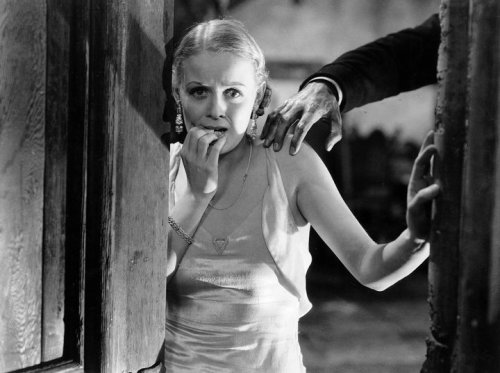
For reasons I shall explain in a minute, The Old Dark House, though it’s reasonably well known due to it being the second of the four Universal horror movies directed by James Whale, is one of the least seen of these films and wasn’t usually included in seasons of these movies when shown on TV. This is a shame, because it’s a highly enjoyable, clever film, though in my opinion not quite the masterpiece some critics claim. Very much like a stage play, with most of its running time packed with dialogue, it will disappoint those looking for lots of Gothic chills and does seem to stop as soon as it really gets going, but it’s pretty funny [as soon as you appreciate dryer-than-dry humour], with Whale more interested in making a parody than a serious film. It’s sometimes said that he was never especially interested in horror, which is why his three chillers after the almost entirely serious Frankenstein are very comedic, with the films often mocking horror cliches, though still at times managing to be quite frightening. Of course what Universal really wanted was a sequel to Frankenstein, but Whale was able to hold them off….for a while.
With Murders Of The Rue Morgue almost ready, the first two months of 1932 saw other studios jumping on the horror bandwagon. MGM began Freaks and The Mask Of Fu Manchu [starring Karloff], Warner Bros announced Dr X and Mystery Of The Wax Museum, Paramount prepared Dr Jekyll And Mr Hyde and Island Of Lost Souls, RKO started The Most Dangerous Game, White Zombie, and planned a certain film about a giant ape. With all this going on, Whale was given carte blanche to make what he wanted, especially as it would probably feature Boris Karloff, and chose a novel called Benighted by J.B.Priestley as the basis for his next film. Priestley’s book was serious and highly symbolic, with the odd inhabitants of the house representing various forms of post-First World War pessimism. The credits were packed with British talent Whale knew from the London stage, including a script by playwright Benn W.Levy, though this was later amended by R.C. Sheriff, who was also busy writing a script based on H.G.Wells’ The Invisable Man. The cast was also mainly British with Raymond Massey and Charles Laughton making their US debuts. The Old Dark House, like Murders Of The Rue Morgue, only did average business, though in the UK it was huge and led to the somewhat similar The Ghoul, which would also star Thesiger and the extremely busy Karloff. For some reason Universal lost the rights to the film in 1957 which meant it never featured in seasons of the movies when they were shown on TV, then in 1963 a [mediocre] remake saw the original withdrawn from circulation until a print was discovered in 1967. Sadly, this print was of poor quality so the film has never undergone the restoration many of the other Universal horror films have.
The opening storm is vividly depicted, with a really impressive shot of a small landslide. Yes, you can see where a portion of the collapsing model work is being pushed in front of the model car, but it looks more realistic than a lot of CG you see now. Anyway, the film wastes little time in getting its stranded travellers into the house, where the pace suddenly slows right down and the film becomes extremely heavy with talk. Fortunately, the lack of action doesn’t matter because the dialogue is often amusing and delivered so brilliantly by the cast. “Beds, beds, they’ll have no beds” screams Eva Moore as Rebecca, surely the definition of an old hag, while Ernest Thesiger [in a dry run for his incredible performance as Dr Praetorius in Bride Of Frankenstein] as Horace makes repetition of the simple “have a potato” into something hilarious. On paper, the lines in this movie probably wouldn’t seem that great, but the delivery turns many of them into gems. Of course suspense does start to build with the knowledge of two hidden members of the household that we have not yet seen, though it sometimes gives way to pure strangeness. The 102 year old man is played by a woman and no attempt is made to hide the fact! The possibly deadly Saul is built up to be a scary menace and there’s a brilliant shot of his hand appearing at the top of the stairwell and remaining there while Morgan is the one who actually comes down the stairs. When he finally appears properly he seems the nicest and most normal person in the family. Well, at first!

The climax involves a fair bit of brawling and a fire which mysteriously has disappeared the next morning. I suppose that they didn’t want to show the laborious clearing up, but honestly there’s no evidence that there had been a fire at all. The ending is a bit happier than that of the book, which had an extra death, but the film does bring in a bit of pathos with Morgan cradling another character’s body. We actually care about all these eccentrics, as bizarre as they might be. The five normal characters are interesting too though, these are no dullards, from Penderal singing songs mocking their plight in the back of the car to the possibly homosexual William. Considering Whale and Laughton were both gay, I’m sure I didn’t pick up on things that weren’t actually there, including a back story that seems to miss vital details, and isn’t it odd how his ‘girlfriend’ throws herself at Penderal as soon as she sees him. I haven’t seen such a depiction of a woman totally ‘gagging for it’ in a really old film [well, any film] in ages! The whole background of the family, some of which is told to us, has a perverse element that one can’t really describe, but it’s there, yet we still like these people, which is a good example of the genius of Whale. Whilst Frankenstein is by far the better film, The Old Dark House seems to be a much more personal project for him.
Even though not much actually goes on for the first two thirds, the atmosphere on this film is terrific. Of course there’s the rain and thunder which never stops for a minute until the last scene, and in fact its constant presence becomes a little amusing after a while, but then this film is a borderline-comedy anyway. The interiors of the house are nowhere near as unusual as the inside of Frankenstein’s tower, or indeed Dracula’s castle, but Arthur Edison’s cinematography still employs some strange angles, though actually it’s the people that are photographed especially oddly here. Rebecca is seen looking distorted through a mirror, but there are many cuts involving the members of the Femm family which are very strange, such as two shots following on from each other of the same face which are almost, but not quite, the same. Clarence Kolster’s editing is really quite avant garde, with some scenes ending suddenly and cutting into the middle of other scenes, and it seems totally intended rather than being accidentally created through heavy cutting like Murders Of The Rue Morgue. I don’t know why this element of the film hasn’t been more talked about then it is.
It’s a shame that Karloff, for his second horror role for Universal, and one in which he was top billed, was again not allowed to speak. To be honest, it’s not too interesting a part and one that would have seemed a cliche even in 1932, but Karloff is able to give Morgan some sympathy whilst doing very little, and is also being a little frightening whilst drunk. Fortunately his next part would be a great deal more interesting. Aside from the wonderful Thesiger and Eva Moore, I also love Laughton, with his almost imcomprehensible Northern accent, and it’s fascinating to see Gloria Stewart, elderly Rose from Titanic, as a young woman. The more I think about The Old Dark House, I realise what an odd little gem it is. It’s a piece of fluff, insubstantial and innocuous, but made by people with great intelligence clearly having great fun. It’s nowhere near one of my favourite Universal horrors, but it has considerable charm, with no other movie in the series being quite like it.

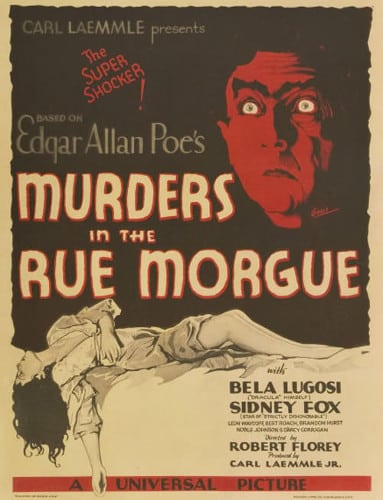


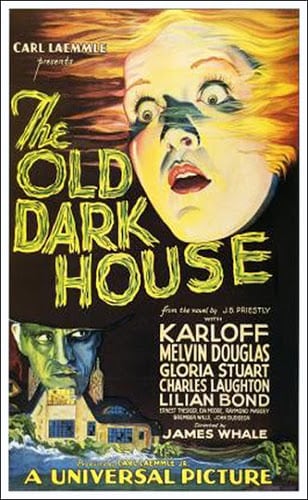

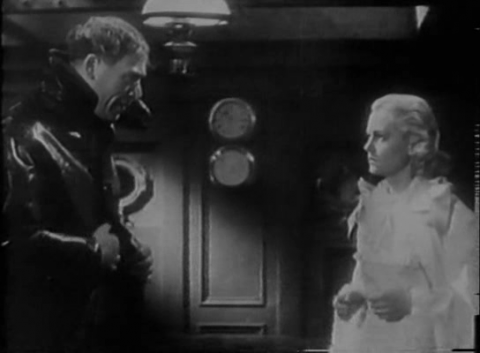
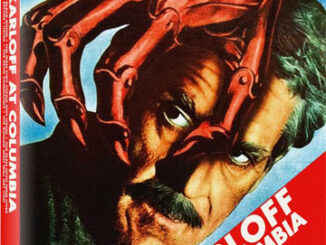
Be the first to comment